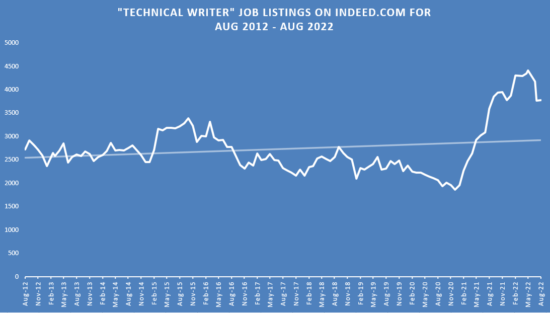
This is the first in a series of pieces that examine trends in the technical writing job market over the past decade.
Long-time readers of this blog will know I have been keeping track of technical writer job postings from Indeed.com for a while now. Indeed.com was the first job aggregator website and has been the single largest such website for a long time; it is the search engine for job postings. It boasts 250 million monthly users, with 10 new jobs appearing on its website every second. Over the course of the past decade, I have been checking on several statistics relating to technical writer job postings: not just the number of job postings but also keywords that appear with them. This includes the names of various software tools associated with technical writing (like FrameMaker, Oxygen, and Acrobat), standards (such as “DITA”, “Markdown”, and “S1000D”), and other keywords related to the profession (including “topic”, “reuse”, and “CCMS”).
While we are no longer at the peak of technical writing hires (which happened in May of this year), we are still in the middle of a major resurgence in the demand for technical writers in the United States.

Up until the beginning of 2021, there had been a steady decline in the number of technical writer job postings. Before the recent peak, and with the exception of a brief surge in technical writing job postings in late 2015/early 2016, there had been a steady decline in technical writer job postings. But the fall became much steeper since the first economic effects of Covid made itself felt in the Spring of 2020 when 10 million Americans were put out of work. By the end of that drop, there were over 1,600 fewer such jobs posted monthly on Indeed.com by early 2021, with almost 20% of that drop happening since the beginning of the pandemic. Around that time, I wrote a piece (that was not published) where I wondered aloud whether there was much of a future for new technical writers entering the job market.
Since then, not only has there been a significant rise in the number of technical writer job postings, but it is higher now than it has been in the past decade. Even with the distinct possibility of a looming recession, the demand for technical writers is still higher than ever.
A key reason for this is the resurgent American economy in the latter portion of the Covid pandemic, which according to The Brookings Institution, was the effect, in part, of the Covid stimulus funding sinking in. Another possible contribution to this is the number of people quitting their jobs is the highest it has been in the past 20 years. I know personally of a couple of people who have retired from the profession, and it is hard for their respective companies to fill their spots that they have vacated.
It is also clear from the statistics that while things are still good regarding the number of job postings, we are now well past the peak that occurred in May of this year. A commentator from TD Securities said earlier this summer that there is a 50% chance of a recession in the U.S. within the next year-and-a-half. Companies may well be pulling back on the number of job postings in general (not just for technical writers) in anticipation of this. One possible example of this is Shopify, which cut 10% of its workforce earlier this summer—including a number of its technical writers, though it should be noted that the company made a bet on a permanent surge of online shopping that did not materialize. One can only hope that those technical writers from places like Shopify are able to find as good if not better jobs in what is still a current hot market.
Another signal of change is the high percentage of technical writer job postings that are work-from-home. The word “remote” appears in fully a quarter of all technical writer job postings on Indeed.com. Speaking personally, I also work from home and manage a small team of technical writers who all work from their own home offices. While many companies are bringing their staff back to the office, resistance to this in some areas is strong, and arguably technical writing is one of those jobs that can just as easily be done from a home office in many cases as within a cubical space in a corporate building. (Much of this depends on the availability and location of Subject Matter Experts, the relative experience and seniority of the technical writers, and whether the infrastructures that were developed during the pandemic were more efficient than before). I think this will be a permanent change in the profession, with a certain percentage of technical writers permanently working from home. I hope to cover the implications of this in a future piece.
While it seems unlikely that we will see continued growth in technical writer job postings in the near term, the job market is better than it has been for a very long time. With so many job postings available, technical writers—especially experienced ones—can and should make the most of what the current hot job market has to offer.
Next: Look for future pieces over the next few days where I plan to focus on specific trends and changes that have occurred over the past decade of watching job postings, including the rise and stagnation of DITA-related jobs, structured vs. unstructured authoring, and what being a “technical writer” means these days.
